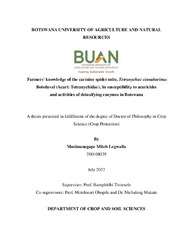| dc.description.abstract | Tomato (Solanum lycopersicon L.) is an important vegetable due to its nutritional and economic value. It’s production has become very difficult and costly due to the prevalence of pests and diseases. Spider mites are among the most damaging pests of tomato in Botswana. The overarching objective of this study was to assess farmers’ knowledge of the carmine spider mite, Tetranychus cinnabarinus Boisduval (Acari: Tetranychidae), its susceptibility to acaricides and activities of detoxifying enzymes in Botswana. An oral questionnaire was used to evaluate farmers’ knowledge, perceptions and management of the carmine spider mite (CSM) on tomato in Botswana. The second study evaluated the effectiveness of selected pesticides for the control of CSM in Botswana. In a third study, the economic injury levels and yield loss were assessed for CSM on tomato. The fourth study evaluated pesticide detoxification enzyme activities in CSM strains collected from different locations in Botswana. The results of the survey showed that most farmers (75.7%) identified spider mites as a major constraint to profitable tomato production. Spider mites reduce the quality and quantity of tomatoes resulting in loss of income. The red form of the spider mites was more prevalent in farms across the country. All the farmers interviewed had prior knowledge of spider mites and their sources of pest information were personal experiences, agro-traders and fellow farmers. Demographic characteristics did not have a significant effect on the seriousness of the spider mite problem. The use of chemical pesticides was the most common method of controlling spider mites. An array of pesticides are applied, some of which are not in the list of chemicals recommended for spider mite control. Some farmers report reduced effectiveness of some of the pesticides used for its control. This has made its control very difficult since most farmers are resource poor and can not afford the cost associated with controlling spider mites. The second study evaluated the efficacy of abamectin, methomyl and vii chlorfenapyr against CSM eggs and adults in the laboratory. The treatments were each replicated three times. The toxic effect was evaluated in the laboratory bioassay after 24, 48, 72 and 96 h of application of pesticides. Chlorfenapyr and methomyl were highly effective in the control of eggs and adult spider mites. Although abamectin required longer exposure periods to achieve effective control of both eggs and adults it did not need to achieve high mortalities to offer adequate protection to the tomato crop. The study showed that the pesticides evaluated can be used as part of an integrated management programme to reduce resistance development by using one pesticide. The third study was conducted over two cropping seasons, 2018/2019 and 2019/2020, to evaluate the economic injury level and assess yield loss for carmine spider mite on tomato in Botswana. Tomato plants were infested with adult spider mites for periods of 0 (no exposure), 1, 2, 3, 4, 5, 6 and 7 weeks (complete exposure). The corresponding treatments were 7, 6, 5, 4, 3, 2, 1 and 0 sprays with abamectin. The results showed a significant reduction in the spider mite populations per plant as the frequency of spraying increased. An inverse relationship between spider mite exposure and yield was also observed following three weeks exposure. Yield loss increased to more than 50% when the pesticide was not applied to control spider mites. Economic decision levels are important components of cost saving integrated pest management programs and can be effective tools for making decisions about the application of pesticides against carmine spider mite in Botswana. The fourth study was conducted to establish pesticide metabolism enzymes activity among CSM strains collected from tomato fields in seven geographical locations of Botswana. Activities of metabolic enzymes, namely, esterases (α and β- esterases), cytochrome P450 monooxygenases and glutathione-S-transferases were estimated. The highest levels of α-esterase activity (nmol/min/mg of protein-1 ) were observed in the Bela-bela strain (1.966 nmol/min/mg of protein-1 ), followed by Sikwane (1.008nmol/min/mg of protein-1 ). The Sikwane strain (3.276 nmol/min/mg of protein-1 ) registered enhanced β-esterase activity, followed by the Glen Valley strain (1.966 nmol/min/mg of protein-1 ) and Francistown (1.102 nmol/min/mg of protein-1 ) strain. Elevated level of GSTs were observed in the Francistown (20.026 nmol/min/mg of protein-1 ), followed by the Moshupa (15.655 nmol/min/mg of protein-1 ) and Bela-bela (15.371 nmol/min/mg of protein-1 ) strains. The Francistown strain showed the highest (0.222 nmol/min/mg of protein-1 ) P450 monooxygenase activity followed by Bobonong (0.193 nmol/min/mg of protein-1 ) and Sikwane (0.135 nmol/min/mg of protein-1 ) strains. Variation in detoxification enzymes activity among CSM strains can be attributed to differing pesticide application regimes. These findings will be helpful in the selection of acaricides and in formulating resistance management strategies for effective management of spider mite in tomato fields in Botswana. | en_US |

